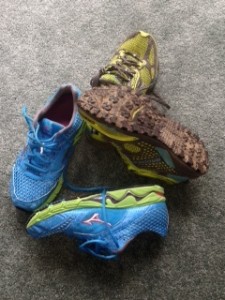Let an expert help you find the right shoes to support your walking and running. You will put hours and miles into your training, so be sure to respect the most important tools you require – your walking/running-specific footwear.
The following appeared in the Rutland Herald/Times Argus Outdoors Section on Sunday, March 30, 2014. To read the full story, visit www.timesargus.com and look for “getting down to the sole of the matter.”
“If the shoe fits wear it?” Wrong. According to Tim Carter, owner of Fleet Feet Sports in Essex ( www.fleetfeetburlington.com), to select running shoes means to consider the 3Fs: Function, Fit, and Feel. “Price,” Carter said “is irrelevant. The shoes have to fit. That’s relatively easy. But, they must work. That’s the key.”
Just because a shoe fits, it doesn’t mean it’s the right shoe for you. The fact that they are comfortable is initially even less important. It is function that takes precedence and “if you don’t get that one right, the others don’t matter,” Carter said.
Before selecting a pair of running shoes, your training partners for about 500 miles, it is imperative to have your feet assessed. Pronation is not a bad thing; over pronation is. The normal footstrike lands on the outside corner of the heel and rolls through the foot to push off the big toe as a lever. “Normal, neutral pronation is just the flexing of the foot when you strike,” Carter said. It is the body’s shock absorber.” It is pronating too quickly or going beyond the normal range that is disadvantageous and can cause trouble. Considering the repetitive motion of step after step, it is easy to see that even a slight problem can crescendo into big trouble.
“About 2% of people supinate,” Carter said. “They pronate too slowly and remain on the outside of the foot rolling off the pinkie.” Size and shape must be measured, but they must be measured to reflect the movement patterns of the foot.
Shoes are categorized as minimal, stability, motion controlled and trail runners. About 20% of the population can safely wear a traditional neutral shoe with no correction to the foot, a shoe that lets the foot work naturally. Minimalist shoes are basically a foot covering and might do for some. If a runner has perfect feet and takes the time (a long time) to gradually accustom his body to running in these “barefoot” shoes, they may be just fine. “ There is not a problem with the shoes,” Carter said, “just the people who wear them.”
There is a vast array of stability shoes that are designed and built to allow the runner to move through the foot strike in an anatomically and functionally appropriate manner. A motion controlled shoe, on the other hand, tells your foot what to do and guides you through the movement. Often heavy, these shoes accommodate those with problem feet or larger runners.
“Trail shoes are a separate entity,” Carter said, a breed of their own, with soles designed to handle the challenging terrain of trails as well as the slippery surfaces of a Vermont winter, “when it is yucky out.”
“Brand doesn’t matter,” Carter said. All brands make all functions. First you must identify your function needs. Be open to fit that may change by several sizes throughout the multiple shoes and versions of shoes available. Be prepared to try a size that you might not have thought possible. Your foot measures differently when it is weight bearing and when it is not. You should be measured at different points of your gait cycle. “There’s no difference between running and walking,” Carter said. In fact, he recommends running shoes for walking.
“Price is not an issue of function,” Carter said. “It is, however, of quality. Once you get to $110, there’s no difference.” When function is determined and you know your size, then it is time to consider how a shoe feels. Try on several and compare. Walk in them. Run in them. Then choose.
Oh my, today’s running shoes are colorful. You may or may not like this. Enter the 4th F: fashion. At this point it’s your choice, your taste.
Buying running shoes is perhaps the most important step to connecting all your other steps into a safe and efficient running gait and successful experience. There are no shortcuts. It is the one significant expense you will have. Be informed and invest wisely. Your feet are what will be asked to sustain many miles of effort, dedication, sweat, fatigue and joys. Treat them well.
“Active Vermont” Linda Freeman

